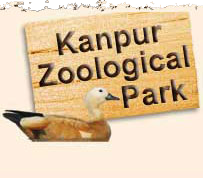History
Kanpur Zoological Park is situated on the fringes of industrial city of Kanpur. The Park is spread in an area of 76.56 hectare. It is part of lush green Allen-forest. The construction of the Park started in the year 1971 and has been developed on the modern management principles. It opened for public on 4th February 1974. In the last three decades the Zoological Park has played an important role in the care of wildlife and awareness of masses regarding wildlife conservation.
Allen forest was developed during the British rule between the years 1913-1918 by Mr. George Burney Allen, a famous British industrialist of Kanpur. The forest has been developed on the banks of the river Ganga. This was a Rest place of Mr.Allen. He constructed a rest house called lake view on the banks of a lake. The lake had a continuous water supply from Ramganga canal. During rains the water use to overflow from the lake and fall in to Ganges. Due to this, many a times big fishes and tortoises use to escape in to the river Ganges. To keep a check on it a bund has been built with sluice gates. In the British, rule this area was situated 5 K.M. away from the city and was a hunting place for English-Business men. Due to the efforts of Mr. George Burney Allen and the then Governor, it was taken into Government possession. A lake, spread in an area of 18 hectares, is a center of attraction since the beginning, as many fishes were in the lake and water birds use to visit the area regularly. The continuously increasing population was a threat to the Allen Forest as there were chances of destruction of this forest due to the increasing biotic interference. Because of the far sightedness of the state Government and the forest department, this chunk of forest area has been converted into a modern Zoological Park.
Construction of the Zoological Park started in the year 1971 and by the year 1975-1976 first 10 enclosures were built. Mr. R. S. Bhaduria was appointed as the first Director of Kanpur Zoological Park, in the year 1971. It was a great challenge for him to convert this area in to a zoo because at that time the entire forest area was known for the criminal activities. Many times the people who were involved in illegal fishing were punished. This also led sometimes to bloody struggle with the people who indulged in illegal fishing in the zoo's lake. In the first phase of the development of the Zoological Park three enclosures were constructed. The 1st animal that came to the zoo was an Otter, gifted to the Director by one of his relatives from Etawah, which was caught by fisherman from the river Chambal.
The construction of the Zoological Park had started in April 1971 and by the end of 1973 about half of the construction had been completed. Many animals were brought in and the number of visitors also increased. Later an official inaugural of the zoo was organized with the advice of Mr. N.D. Bachkheti, the Conservator of Forests, southern circle, Allahabad, under whose official control and direction the Zoological Park was constructed. According to Mr. Bachkheti, the Zoological Park was the children's favorite entertainer. Hence the zoo was inaugurated by a child on the 4th of Feb. 1974 in the early hours, in a very simple ceremony in the Zoo and it was made open for the public.
Initially 10 enclosures were proposed and constructed from the year 1971-72 to 1975-76. The enclosures were designed according to the modern management principles. Every enclosure had ample greenery so that the animals could feel at home between the natural available atmosphere. Feeding houses were also constructed with squeeze cages in the houses of the tiger, lion, leopard and other similar species. This arrangement was very helpful for the treatment when they were sick. Moat of the Tiger enclosure have been so designed that there is sufficient water in itfor the tiger to play and it is pleasant and pleasing sight for the visitors. Later many more enclosures were added to accommodate various other animals and various development works continued and were added from time to time every year, according to the provisions of the budget of the State Government and Central Zoo Authority (CZA).
The enclosures for animals and birds were designed on the latest trends in the field of zoo building technology, well spread along the lake on either side of a semicircular arterial road of about 9 km. length, in such a manner that the natural look of the forest was not disturbed and the natural topography and floral richness of Allen Forest was fully utilized.
Though so many enclosures, buildings and roads are constructed in the zoo premises, still there is vast untouched area, which gives it a look of dense forest. Subsequently, a variety of free roaming animals are thriving in the zoo premises. These consist of Spotted deer, rhesus monkeys Hanuman Langurs, many common civets, hares, porcupines, squirrels, bats, mongoose, lizards, snakes, pythons, common pea fowls, partridges, parakeets, owls and a variety of birds etc.












